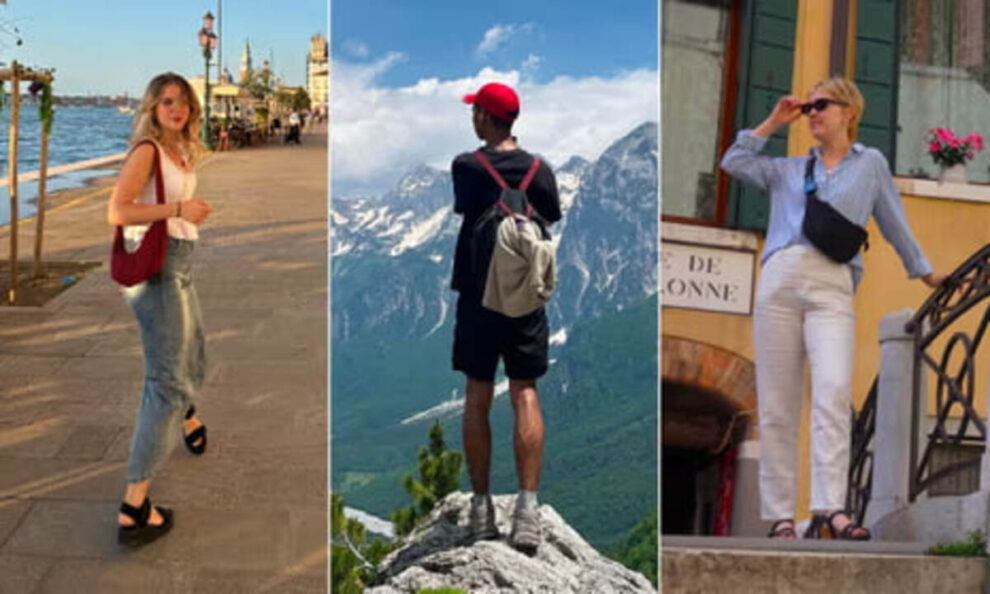Like several hundred-thousand Australians, last winter Mary McGillivray left her puffer jackets behind in Melbourne to spend a northern summer in Europe. But McGillivray had a special project in mind: she planned her Euro-summer like an 18th-century British aristocrat, and went on a grand tour.
McGillivray evaded wolves in the south of France, admired the Rococo menswear of the continent and pondered dalliances with the locals in each destination.
The art historian and creator has been documenting her travels – which trace the same routes taken by British travellers from the 17th through to the 19th century – on TikTok. So far, her video essays have amassed more than 2.5m views.
Partly sponsored by the European Travel Commission, McGillivray’s history series focuses less on sun-drenched beaches and more on climate-controlled museums. It’s a refreshing take on the travel trend that has flooded the platform this year, a Tomato Girl Summer with a Ways of Seeing twist.
“I knew this was a good year to do a grand tour series,” McGillivray says. “Euro-summer was everywhere on TikTok. I didn’t really see any other kind of travel content.”
McGillivray says the escapades of British aristocrats – “the first tourists” – might at first seem like a far cry from the grittier Australian gap year. “We’ve distanced ourselves a bit from the history,” she says, but, “Australians are still very drawn to Europe.”
“We like to think that there’s no class structure in Australia like there is in Britain,” she says. “But the impacts of the grand tour on Australia are really strong.”
For instance, the grand tour has seeped into Australian architecture: think the Ionic colonnades of the Art Gallery of New South Wales in Sydney, designed by Walter Liberty Vernon, an English architect, in 1906.
“The foundations of Australia as a colonial country during British expansionism were greatly informed by the values gained from the grand tour, artistically, politically, and culturally,” McGillivray says.
This year Europe is back in fashion, says Dominic Michaelis, a Flight Centre team leader at George Street Sydney. “[Young Australians] are wanting to tick travelling-Europe-whilst-young off their bucket list; and avoiding more adventurous and more complex destinations such as south-east Asia and South America.”
Data supplied by the Australian Bureau of Statistics shows that today, 15% of young Australians spending four months or more abroad are choosing continental Europe, up from 9.5% in 2005.
Gen Z differ from recent generations on this front. The total number of younger travellers leaving the country for four months or more has declined. There are pronounced falls in visits to both adventurous find-yourself locations like Thailand and India and working-holiday spots like Canada and the US.
Even the UK, a classic gap year spot, is waning in popularity. Though it is still one of the most visited destinations, the total number of returning young Australians fell from 35,960 between June 2004-5, to 9,590 last financial year.
Meanwhile, one of the few destinations to record an increase in these visitors, for both shorter and longer stays, was Italy.
Europe’s accessibility is particularly appealing: extended travel is easier on a well-beaten track.
Martin Tan, who is now hiking in the Scottish Highlands, says: “There’s a cultural blueprint for Australians to go backpacking through Europe.”
His sister and her friends had already made a similar trip; which let Tan plan out everything before he left. He had plenty of time to do so – “I always knew I wanted to have a gap year,” he says. “I initially saved up for it since year nine.”
With pandemic travel restrictions long gone, Tan “wanted some time to figure out what I wanted to do, because I wasn’t really in love with what I was doing in uni”.
“I think Europe is a lot more juvenile. I want to do Asia; I want to go to South America. But I feel it’s not accessible at this age… I’m maybe a little too young to appreciate that. I’d want to go when I’m older.”
Australian passport holders can enter the European Union visa-free for a 90-day period. Despite all his planning, Tan ended up cutting quite close to that deadline. “I was stressing out,” he says. Then, his sibling networks saved the day. “I asked one of my sister’s friends and she told me ‘Go to Albania.’” A quick trip out of the Schengen area allowed him to travel freely again for a further few months. “She gave me this article which explained everything, and I booked it all within the day.”
For Shea Donohoe, a recent communications graduate from the University of Technology Sydney, “Europe was a no-brainer”. A solo traveller, Donohoe started off in the UK in May, then spent the next four months making her way around the continent, from the sharp-vowel towns of Germany to the galleries of the Czech Republic. She people-watched on canals in Amsterdam and Paris and finally spent the summer between Italy and the south of France.
“The initial attraction was that I was going by myself, and going somewhere that’s interesting and very different to Australia,” she says.
The ease of staying in Europe also makes a trip ideal for scouting potential places to live long-term. “A lot of Australians go [to Europe] and stay there because of our amazing visa arrangements,” says Dr Clifford Lewis, a tourism marketing academic at Charles Sturt University. “So that’s not really travel, it’s more relocating for extended periods.”
Lilli Teale spent her first half year of university studying through lockdowns, then spent several months backpacking and visiting family in Europe. “What I wanted from uni was not going to be fulfilled by doing it remotely,” she says. “I was interested in the social life, the beautiful grounds.”
“Europe was my fig tree,” Teale says, referencing Sylvia Plath’s famous passage in The Bell Jar. “It was a way to get a little taste of each fig … I see so many possibilities in moving to Europe.”
Like Teale, Donohoe was drawn to Europe for its cultural potential. “I loved being in a place that has artistic roots,” she says. “So much art and theatre happens there … [Australia] doesn’t have much of that.”
“All of the Australian artists from the 19th to the early-20th century went to Europe,” says McGillivray. “There was this idea that you weren’t really a good artist unless you trained in Paris or London. And that persisted right into the 80s.”
Europe gave artists “the training, the expertise, and the knowledge that they just couldn’t get in Australia,” she says.
Lewis says that travel brings both perspective and challenge. It enables the kind of self-development that may have been stunted for students starting university during Covid lockdowns. “[These] contribute to that sense of growth … confidence building, in terms of one’s identity as a person, and one’s identity as an adult.”
In that way, a gap year fulfils the same need as a grand tour once did, albeit for more people and with less prescriptive destinations. “These needs tend to remain the same,” Lewis says. “It’s the places they visit that tend to change.”
Source: The Guardian







































